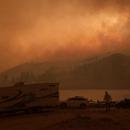It was Labor Day 2020, and Mammoth Pool Reservoir, in California’s Sierra Nevada, was buzzing with campers. Karla Carcamo and her parents, siblings, cousins, and countless others, mostly from the Los Angeles area, have been coming here every Labor Day for 17 years. “Most of it is my family, and family that’s invited family, and those family friends have invited friends of theirs,” she says. “I’m telling you, we have over 200 people.”
Alex Tettamanti and her husband Raul Reyes are also Labor Day regulars. Every year, they drive in from Las Vegas to meet up with an off-roading club made up of a few dozen families from across the West. They fill their weekend with jet-skiing, ATVing and hiking. “It’s beautiful,” says Tettamanti. “The smell of all the pine trees and stuff, and the trees are so big, it’s really cool.
The campground and reservoir are nestled at an elevation of about 3,000 feet in the Central California foothills a few hours northeast of Fresno. The attraction is unfiltered Sierra Nevada: Sparkling blue water surrounded by a thick forest of stately ponderosa pines and black oaks. Plus, it’s isolated. There’s only one road in and out, which dead ends at the lake. “Being there, let me tell you, it’s like a little piece of paradise,” says Carcamo.
That Friday passed like any other. Groups split up to go hiking, swimming and grilling, and Carcamo’s family prepared for their annual pupusa night later in the weekend.
By Saturday morning, however, the atmosphere had changed. “When I woke up, I did notice it was kind of cloudy,” says Reyes. “The sky was orange and there was ash, like big pieces of ash falling,” says Reyes’ friend Vicky Castro.
Read the rest at sciencefriday.com.
Squirrel-Nut Economics And Other Agility Tricks
In many parts of the country, the lead-up to winter is a busy time for squirrels, furiously collecting and hiding acorns and nuts for the cold months ahead. But how can squirrels recall where it has stashed all its stores? And what can studying squirrels tell researchers about memory, learning, and economic decision-making in other species?
Ira talks with Lucia Jacobs, a professor in the department of psychology and the Institute of Neuroscience at UC Berkeley, about her studies of the campus squirrels—from learning about their cognition, learning, and memory to recording the acrobatic movements of a squirrel on the ground and in the treetops. Jacobs co-leads a "squirrel school," observing rescued and orphaned juvenile squirrels as they learn normal squirrel behavior, and is contributing to a project seeking to develop robots using agility tricks learned from the rodents.
What Will We Reap Without Topsoil?
You may have missed the research when it came out this February: a paper in the Proceedings of the National Academies of Science reporting on satellite studies of farmland topsoil in the nation’s corn belt, states like Iowa, Indiana, and Illinois. And the news was not good. The team estimated that more than one-third of the topsoil in this region is gone, eroded mostly from hilltops and ridgelines, thanks to the plowing and tilling processes used to perform industrial agriculture. That topsoil, some of the richest in the world, is carbon-rich and crucial to our food supply. And yet it’s continuing to wash away, a hundred years after scientists like Aldo Leopold first called out the threat of erosion.
This erosion, as well as other degradation of soil’s complex structure and microbiome, continues at a fast clip around the globe, hurting food production and ecosystems health. In addition, soil could be helping us contain more than 100 billion additional tons of carbon dioxide from the atmosphere—if we let it. But the good news, according to University of Wisconsin soil scientist Jo Handelsman, is that the solutions like cover crops and no-till farming are simple, well-understood, and easy to implement—as long as we give farmers incentives to make the leap. She talks to Ira about her forthcoming book, A World Without Soil: The Past, Present, and Precarious Future of the Earth Beneath Our Feet.

science-friday111221b.mp3 (52:39, 48MB)

